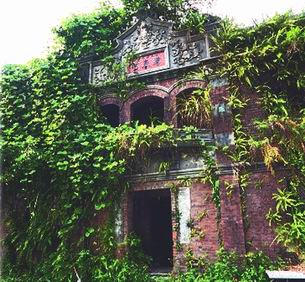 Tomb of Lin Xiu-jun
Tomb of Lin Xiu-jun The Taipei Basin was settled and developed at the beginning of the Qing dynasty by people from the Zhangzhou and Quanzhou areas of Fujian province, as well as Guangdong province.
Lin Xiu-jun, considered one of the area’s most important pioneers, was born in 1699 and died in 1770 at the age of 72. Hailing from Zhangzhou, he migrated to Taiwan when he was around 20. After turning 50, he took the name Lin Cheng-zu and devoted himself to developing the area from Baijiebao to Dajia’nabao or the present-day Banqiao, Tucheng, Yonghe, Zhonghe and Neihu. The design of his grave follows the traditional southern Fujian style, with a mound in the center, a carved tombstone in front, flanked with stones. A short, curved wall encircles a broad court in front of the tomb. Designed according to the principles of fengshui, it is one of the very few completely intact large-scale tombs dating from the Qing dynasty in the Taipei Basin.
High quality stone can be found in plentiful supply along the outer edges of the Taipei Basin. At the end of the 19th century, the Qing dynasty government decided to construct the new city of Taipei, choosing to build its fortified wall with the andesite found in the mountains of Neihu and Dazhi. These old stones can still be seen in the culvert and walls of the former jail next to the Jinshan South Road offices of the Directorate General of Telecommunications. In addition to serving as material for the city wall, Neihu stone was also widely used as building material by the general population throughout the Japanese colonial and post-World War II periods.
Recently, the Neihu Quarry was closed for environmental reasons. Signs of excavation are still readily visible, as is a slope specially made for sliding stones down the mountain – evidence of the history of Old Taipei’s construction.
 Guo Family Estate
Guo Family Estate
The home of the first Neihu Village mayor during the Japanese colonial era is located on a hill on the west side of Neihu’s old district. Built in 1919, it boasted Baroque-style embellishments, red brick, washed terrazzo, earthen sculptures and colored decorative tiles – all highly popular features of Taisho-style architecture.
Typical for a luxury home of the era, the house faces south and is surrounded on three sides by woods. The floor plan roughly follows a “T” formation. The predominant building materials are brick and wood. The exterior walls are made of red bricks and decorated with washed terrazzo and colored tiles imported from Japan. The floor is made of wood and supported by wooden beams. Another beam was specially used to hang traditional Taiwanese censers and lanterns. The facade’s elegant curvilinear design features windows of irregular shape, a curved, protruding balcony and a faux Baroque gable. A plaque has been added to the gable crest in recent years, bearing the name Bi Feng Temple. Despite this designation, however, it was never converted for religious use.
 Neihu Village Public Hall
Neihu Village Public Hall
Neihu Village was first established in 1920 during the Japanese colonial period. The Neihu Village Meeting Hall was built in the center of Old Neihu around 1935. The lofty roof and the entrance facade employed architectural styles popular at the time. The meeting hall facing north featured a rectangular layout. The entrance was set in the middle of the front gable, looking out on old Neihu Village. The triangular gable has three round windows bordered with ornamentation. The roof ridge employs a stepped design typical of Art Deco from the 1920s. The horizontal entrance canopy features semicircular pillars at the sides. Of particular interest are the light green glazed tiles with reticulated patterns on the walls. The tiles, designed for defense against air raids, do not reflect light.
Old Sluice Gate of Shisifen Canal
![]() Previously, “Dahu Park” was called “Shisifen Pond,” built by the Lin Hsiu-Chun family, a licensed developer in Neihu. From the Qing dynasty to the period of Japanese rule, the pond was used for the irrigation of the Neihu area. In July 1907, it was approved as a public canal, and a sluice gate and other affiliated facilities were built. The existing sluice gate now embodies the history of the development, water conservation, and agriculture in the Neihu area, and is worth preserving.
Previously, “Dahu Park” was called “Shisifen Pond,” built by the Lin Hsiu-Chun family, a licensed developer in Neihu. From the Qing dynasty to the period of Japanese rule, the pond was used for the irrigation of the Neihu area. In July 1907, it was approved as a public canal, and a sluice gate and other affiliated facilities were built. The existing sluice gate now embodies the history of the development, water conservation, and agriculture in the Neihu area, and is worth preserving.
Qing Dynasty Quarry in Neihu
Wu Fen Suspension Bridge
Wu Fen Suspension Bridge is one of the few suspension bridge ruins along Keelung River. It was a major![]() traffic route constructed in early times to facilitate coal transportation in the Neihu area. Now, the ruins witness the history of the development of local industry. The suspension bridge was one of the few bridges running across Keelung River exclusively used for the transportation of coal in the Neihu area. It was demolished in the 1970s and 1980s. Now, only the bridge mast on the northern shore remains.
traffic route constructed in early times to facilitate coal transportation in the Neihu area. Now, the ruins witness the history of the development of local industry. The suspension bridge was one of the few bridges running across Keelung River exclusively used for the transportation of coal in the Neihu area. It was demolished in the 1970s and 1980s. Now, only the bridge mast on the northern shore remains.

![Taiwan.gov.tw [ open a new window]](/images/egov.png)
